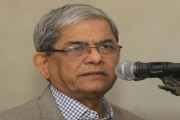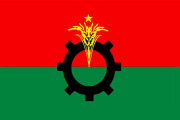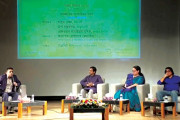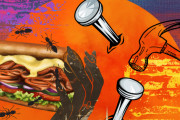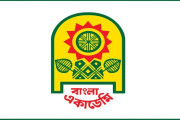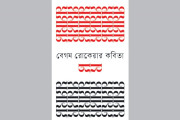Though upset by the sheer poverty of the people of Bengal due to the corrupt and unscrupulous politics coupled with the 1943 famine, Ritwik exhibited a tinge of hope, optimism, and courage in his films. The injured characters, destroyed by the gimmick of life and partition, still dare to leap forward.
।। Ariful Islam Laskar।।
“Why must I leave? Can anyone make me understand? Leaving behind such an adorable country, parting my river Padma-why must I take off?”
1961 film Komal Gandhar starts with the above dialogues as a despairing old actor, on stage, desperately vows not to sever him from the root, his homeland Bangladesh (East Bengal). His co-actor warns and reminds him by evoking that ‘this is the last chance to become refugees’ at which the old man retorts in wonder and astonishment- ‘Refugee?’
Ritwik Ghatak dislikes the word and the idea of ‘being a refugee.’ He is completely exasperated with the term ‘refugee problem’. To him, it is a division culminating in devastating cultural shock. Ritwik himself displaced from Bangladesh to Calcutta always loved to be identified as a Bangladeshi. On many occasions, he unpretentiously pronounced, “I am a Bangladeshi.”
Satyajit Ray correctly equates that ‘Ritwik was a Bengali from the bottom of his heart; he was a Bengali artist- a lot more Bengali than me.’ Satyajit also opined that Ritwik is none but ‘a man very drawn and close to Bengali people.’
The partition of Bengal pulled Ritwik apart as it leaves inexplicable scars and pains in his soul. As such, most of his movies render a horrid tale of separation where the anxiety and trauma of rootlessness are visible like fresh sores.
Being displaced and distraught, all the characters in Ghatak’s movies fight for their mere survival putting a wry and half-hearted smile on their faces. But, somehow, their yearning for life does not fade away. They also desire to grow and flourish like an injured plant or a bird who desperately fights and struggles to return to their previously strong position. Their ever-tormented souls do not give them rest; the bitter experiences and hardships of life make them almost crippled; however, from the very deep down, Ritwik does not let his characters totally fall from the aspiration and drive of life.
Besides the Shillong hill sanatorium-Nita-the protagonist of the movie-Meghe Dhaka Tara (The Cloud-capped Star), 1960- shouts and urges, ‘Dada, yet I wanted to live. I really love to live. Dada, I will live. Dada, I will live.” Nita’s agonizing yell and passionate yearning to live echoes in the hills and creates pulsating resonance in the heart of each audience of Ritwik’s films.
The narrative revolves around Nita, who is mentally betrayed and battered by her dear and near ones, single-handedly run the impoverished educated family who lives in a tattered refugee colony.
Ritwik was so drawn and moved by the depressing condition of the society from very close proximity, he witnessed the lingering and languishes of the despicable and unfortunate ‘children of partition.’ Ghatak thus tightly declares that “The characters of my film yell and urge to live. At the face of death, they want to live as if it’s not the death; instead, the proclamation of the victory of life.” They do not bob down by the thrashing of an upsetting and humiliating life.
Subarnarekha (The Golden Thread), once more, paints the vulnerable and depressing state of the refuges of East Bengal. Even for the better future of his sister Seeta-we see, Ishwar moves from Calcutta to a lifeless and inert Chatimpur, in neighbouring Bihar- a migration within the migration.
With time, the audience painfully observes: Ishwar loses his ideals, Seeta elopes with Abhiram and loses everything to turn into a prostitute, and ironically, her brother Ishwar visits her as a customer in the end. Haraprasad, a friend of Ishwar, having lost track and taste of life seen to mutter, “I am a blasted palm tree. I had protested. What protest? Protest against what? Now, I have knocked against a wall.”
Likewise, at the beginning of the cinema, we see Seeta asks, ‘Haraprasada dada… is it our new home…then, why much fighting here…?’ Fighting never ceases in the life of refugees. They continuously adapt and adopt to their ever-changing course of life. Settlement and security are the insulin in their life that they always seek but are deprived of. Here, Ritiwik the director, seemingly taking the role of painter Picasso, sketches in the minute details-the inside and outworld war of the characters of his films.
Ritiwik is a truth-teller and seeker. As the film is a social art, he admits that ‘ … then films have a duty to the society.’ Hence, he never felt like making fully commercial films and never opted for a cheap way out to make an establishment. He was, in fact, an anti-establishment, anti-colonial, and anti-fascist filmmaker. Inspired by the Marxist ideals, he felt the urge to make films on class struggles and life’s struggles. However, Ritiwik frankly states that he is not here “to please any political ideology.”
Again, in Jukti Takko Aar Gappo, Nilkantha Bagchi, the alter ego of Ritwik Ghatak, roams with Jagannath, and Bongobala, the deserted and wrecked Bengalis of partition. The movie criticizes the corrupted society and amoral politics. Nilkantha ironically and peevishly remarks and tags himself as a “Broken Intellectual’ and mockingly articulates: “I am the member of this eroded society.’ Though upon meeting the young Naxalites, he praises them; he then terms them ‘misguided.’ He even criticizes our illusory nature of being in this critical juncture: ‘Either we are thieves or disenchanted, or fleeing like cowards…we are no pure men.’
Ritwik felt that partition had ruined all the hopes and dreams of people, and that prompts him to film the fragile and broken lives of homeless people who constantly live full of uncertainty and doubt.
In Komal Gandhar, a doubly ripped apart Anusuya-a refuge in Calcutta- struggles to win her love and cannot fully involve in a romantic affair as she is peculiarly committed elsewhere by a wedding which remains unconsummated for years. However, Ritiwik, the uncanny optimist, lets Anysuya and her lover and co-artist Bhrigu-another refuge meet each other as if it is the meeting of Bengal and a new beginning- a melting pot indeed.
The singular catastrophe of partition is immense in personal life and the political sphere. The splitting of India gave hope of independence and good life though, it was divisive in nature and it displaced, and killed hundreds and thousands of people. It created borders that set people apart from their roots. People now see permanently militarized borders and sectarian killings. On top of everything, now, a layer of mistrust always prevails.
Even the steadfast supporters of partition see the negative impacts of displacement, especially on the psyche of the people of the subcontinent. Ritwik Ghatak has blamed both the Muslim League and Congress for this heinous act. He even voiced that partition must not be termed independence: one can-if he pleases, call it a ‘ruined independence.’ It is a matter of shame as it is an entirely sham one.
Ritwik, the neglected maverick of Bangla Cinema, does not spare anyone from the blame as the broken but nor defeated Nita’s father of Meghe Dhaka Tara dramatically shouts, ‘I accuse…!’ The realist Ghatak, however, blames ‘Nobody’. Though, in Jukti Tokko Ar Gappo, he pleads to the people, ‘think, think… I could not do anything—hope one day, you will if you think…”
Though upset by the sheer poverty of the people of Bengal due to the corrupt and unscrupulous politics coupled with the 1943 famine, Ritwik exhibited a tinge of hope, optimism, and courage in his films. The injured characters, destroyed by the gimmick of life and partition, still dare to leap forward.
Ritwik through his films delineated: no to division and war and like Lennon, to have a better world, we must sing in unison, “imagine there’s no countries…”.
The writer is a columnist and teaches English Literature at a private University. E-mail: y2k.arif@gmail.com






















